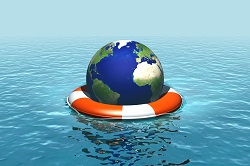Even in best-case emission scenarios, sea levels may still rise until 2300
Scientists have long warned of rising sea levels as a major consequence of human-driven climate change, and the effects can already be seen today. Higher temperatures generated by our greenhouse gas (GHG) emissions are increasing the volume of ocean waters and melting mountain glaciers, ice caps and ice sheets. Even more daunting, the full impact of our current emissions will only be felt centuries and even millennia from now. Despite the number of studies predicting sea level rise in the coming centuries and beyond, none had examined how future sea levels would be affected if the 2015 Paris Agreement’s goals were met. This gap in scientific knowledge was tackled by an international team of researchers, one of whom received EU funding under the projects CD-LINKS and CRESCENDO. Their findings, published in ‘Europe PMC’, show how the Paris Agreement’s constraints will affect sea level rise until 2300. In an effort to limit global temperatures to well below 2 °C, or – even better – 1.5 °C, above pre-industrial levels, the Paris Agreement calls for countries to peak GHG emissions as soon as possible. After peaking, emissions should be reduced so that man-made GHGs would be balanced out by the levels naturally absorbed by trees, soil and oceans. The aim is to achieve this balance, called net-zero GHG emissions, between 2050 and 2100. The project team explored various scenarios. It compared the effects of net-zero GHG emissions with net-zero carbon emissions (excluding other GHGs such as methane and nitrous oxide) on future sea levels. Sea level rise was estimated based on emission reduction rates of 0.3 0.5 and 0.7 gigatonnes of carbon per year after peak emissions are reached. How much will global sea levels rise? Depending on how soon we begin reducing emissions this century, the scientists found that we can expect sea levels to rise between 0.7 and 1.2 m by 2300 if we maintain net-zero GHG emissions until then, and this despite falling global temperatures. Even more dire, if only CO2 emissions are balanced in the same timeframe, the expected sea level rise is 1.1 to 1.6 m. Further underlining the importance of immediate action, each 5-year delay in reaching global peak emissions leads to an extra 20 cm in sea level rise by 2300. Additional estimates also showed that stabilising global temperature below 2 °C above pre-industrial levels is not enough to keep the sea level rise below 1.5 m when only CO2 emissions are considered. In fact, once temperatures pass 1.5 °C, no net-zero CO2 scenario shows a sea level rise below 1.2 m by 2300. More optimistically, with net-zero GHG emissions, for every 10 years that temperatures exceed 1.5 °C, average sea levels rise only by an additional 4 cm. It’s therefore clear that early peaking followed by strict emissions reductions is vital if we are to keep sea level rise at a minimum. Any delays in taking action will leave a grave legacy for future generations. The CD-LINKS (Linking Climate and Development Policies – Leveraging International Networks and Knowledge Sharing) and CRESCENDO (Coordinated Research in Earth Systems and Climate: Experiments, kNowledge, Dissemination and Outreach) projects will be using their accomplishments to date to further contribute toward informed policymaking for climate change mitigation. For more information, please see: CD-LINKS project website CRESCENDO project website
Countries
Austria, United Kingdom



